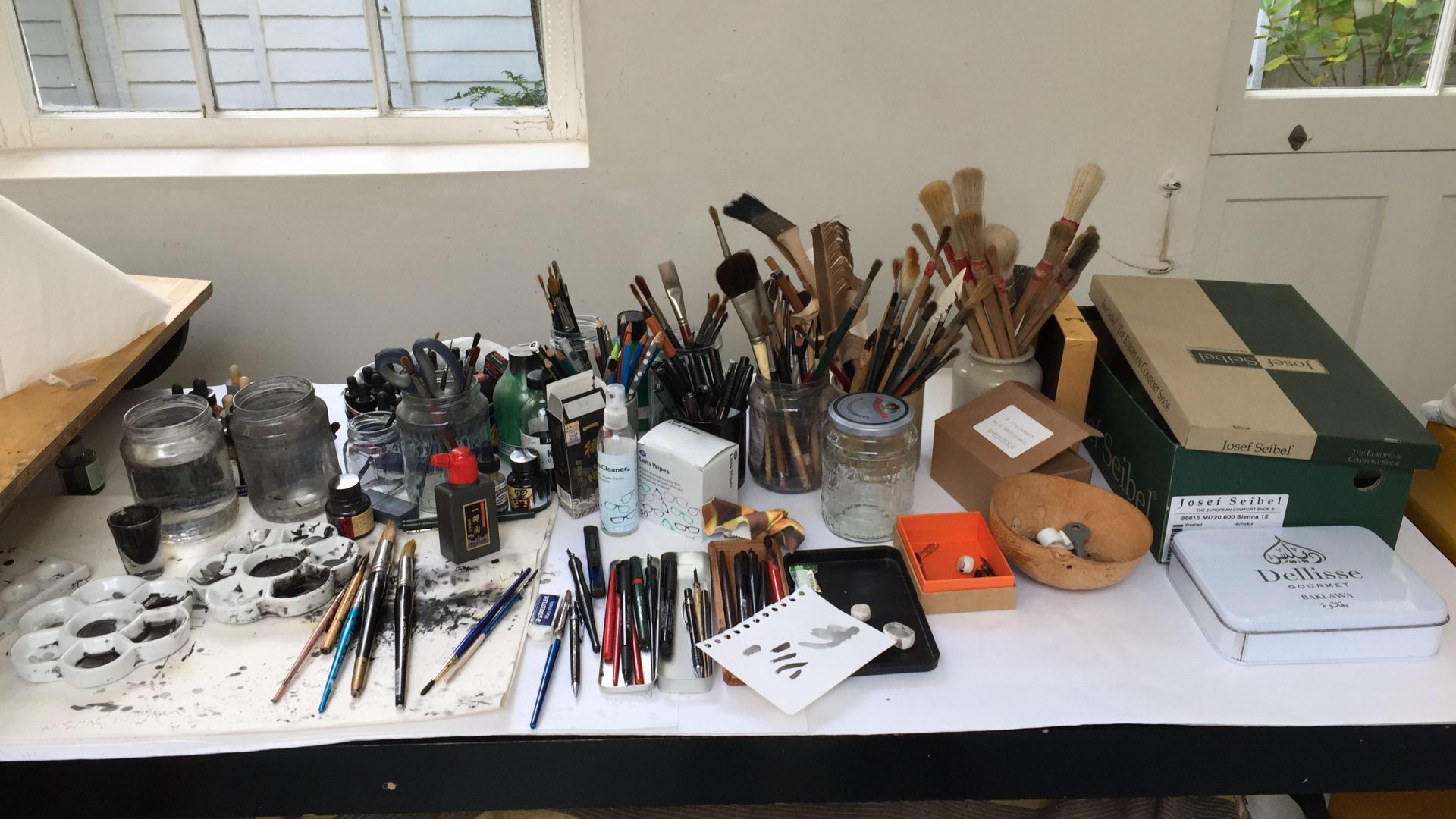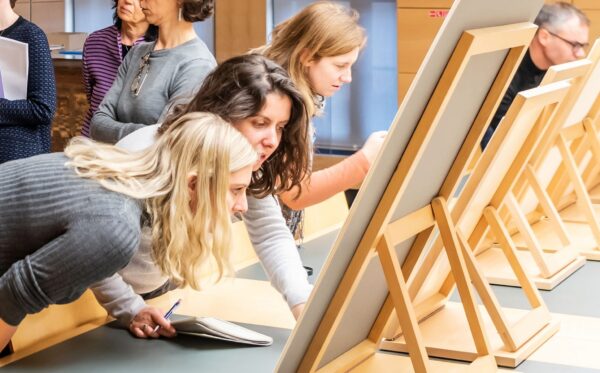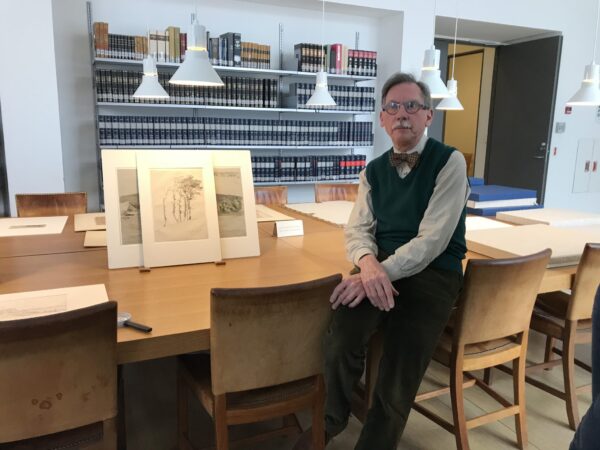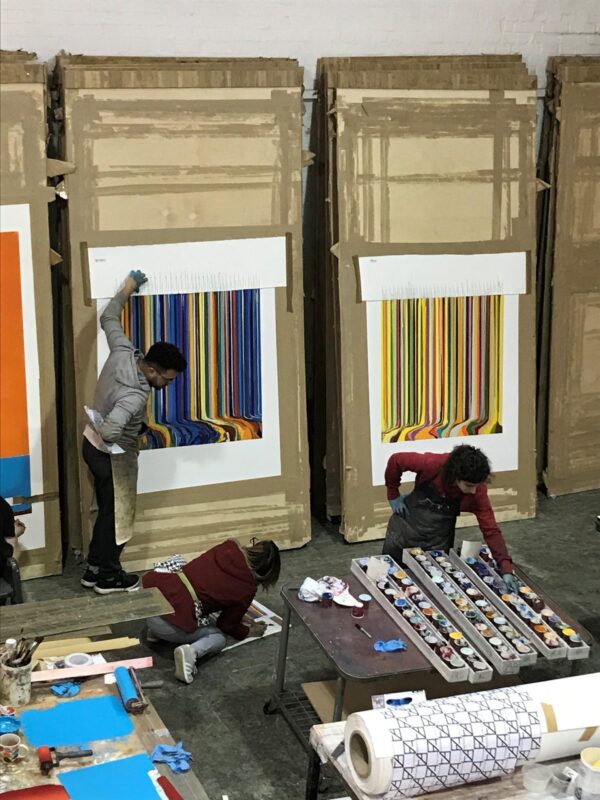
Graphic Arts Group
About
History
The Graphic Arts Group originated in 2006 in conversations between Mark McDonald, then curator in the Department of Prints and Drawings at the British Museum and Patricia Rubin, at that time Head of the Courtauld Institute Research Forum. The aspiration was to provide a regular opportunity for those interested in the graphic arts, broadly defined, to meet and to engage in conversation around objects in the Print Room. GAG benefited from the generosity of the Department of Prints and Drawings in opening its treasures to the group, after opening hours, and owed everything to Mark McDonald’s commitment to sharing those resources in active engagement.
The group was open to students and staff from both institutions and to others with a special interest in prints and drawings. Participants were invited to suggest works and lead the discussion. As the sessions evolved, it was decided to set a broad theme. The conversational format fostered lively and informative exchange. The group composition was fluid and open, and it quickly attracted members with many different interests, revealing how central prints and drawings are to artistic practice and art historical understanding. The evenings always ended with supper at the local Turkish restaurant, where conversations continued. The connections between the members and their interests and their insights have informed research projects. Both founders are proud that GAG has continued and that its ethos of free and creative exchange has endured.
Patricia Rubin, Professor Emerita, The Institute of Fine Arts, NYU; Honorary Research Fellow, The Courtauld
Dr. Mark McDonald, Curator of Drawings and Prints, The Metropolitan Museum of Art, New York
Topics discussed
Academic Years:
2023 – 24
– September 27, 2023: Dr Rachel Hapoienu, Assistant Curator of drawings at The Courtauld, led a visit and group discussion of the Courtauld Drawings Gallery display that she curated Art and Artifice: Fakes from the Collection.
– November 3, 2023: Tanya Bentley, Curator of Contemporary Art and of the Lucien Freud archive, and Paul Cox, Curator of Prints at the National Portrait Gallery led a visit and discussion of the newly reopened galleries dedicated to prints and to the Freud archive.
– November 16, 2023: Dr Edward Wouk, Reader in Art History at the University of Manchester, and curator of the exhibition Albrecht Dürer’s material world at the Whitworth Gallery in Manchester took the Graphic Arts Group around the show discussing challenges, choices and outcomes of his fascinating project.
– February 20, 2024: Dr Barnaby Wright, Deputy Head of The Courtauld Gallery and Daniel Katz Curator of 20th Century Art, presented the exhibition he curated at The Courtauld Frank Auerbach. The Charcoal Heads, and discussed in depth these extraordinary early portraits which Auerbach created during his early years in post-war London.
2022 – 23
– December 12, 2022: The Ashmolean’s collection of early-modern German drawings, a project funded by the Getty Paper Project; meeting in the Print Room of the Ashmolean Museum in Oxford. Speakers: An Van Camp, Christopher Brown Curator of Northern European Art, and Mailena Mallach, Ashmolean-Getty Paper Project Curator for the German drawings
– December 15, 2022: visit and discussion within the drawings exhibitions at The Courtauld: Fuseli and the Modern Woman: Fashion, Fantasy, Fetishism, with the co-curators of the exhibition Dr Ketty Gottardo and Emeritus Professor David Solkin. And Helen Saunders: Modernist Rebel with Dr Rachel Sloan, curator of the exhibition
– March, 2023: Dr Venetia Porter, Curator of Islamic and contemporary Middle East art at The British Museum, led a tour and discussion of the display she curated: Artists making books: poetry to politics (Albukhary Foundation Gallery of the Islamic world, at The British Museum).
2021-22
– February 1, 2022: Printing Colour: Renaissance Germany/Victorian Britain. Speakers: Dr Elizabeth Savage and Dr Kirsty Sinclair Dootson (webinar)
– May 12, 2022: Visit to the Courtauld Gallery’s display Parmigianino at The Courtauld: The Art of Experiment with Dr Ketty Gottardo and Dr Guido Rebecchini
– June 28, 2022: Visit to the studio of artist Alison Wilding with members of the Sculptural Processes Group.
2020-21
– March 25, 2021: Reflections: contemporary art of the Middle East and North Africa. Artist’s books. Speaker: Dr Venetia Porter (webinar)
– November 5, 2020: Digitizing the Graphic Arts. Speakers: Antony Griffiths, Arielle Llupa, and Frank Ligterink (webinar)
2019-20
-November 14, 2019: visit to the studio of Deanna Petherbridge, London
-November 7, 2019: visit to Thumbprint Editions (printmaking studio in Camberwell, London)
-March 2020 [Cancelled due to the pandemic]: Print Matrices: a cross-over session with the Courtauld’s Sculptural Processes Group at the British Museum
2018-19
-April 2019: visit to the British Museum’s Rembrandt: thinking on paper exhibition with curator Dr Olenka Horbatsch
-March 7, 2019: Transformations (British Museum Print Room)
-Autumn 2018: visit to the Italian drawings exhibition The Realm of Possibilities: Italian Drawings of the 16th Century organised by the Kupferstichkabinett in Dresden at the Residenzschloss in Dresden; and visit to their print room to discuss further works on paper there
2017-8
-May 17, 2018: visit to the exhibition Artists at work (The Courtauld) led by its curators Deanna Petherbridge and Anita Sganzerla
-March 2-5, 2018: visit to the exhibition Art in the making (Copenhagen, Staatens Museum), led by its curator Chris Fischer
-November 23, 2017: Migrations, part II (British Museum Print Room)
2016 – 2017
-May 18, 2017: Migrations, part I (British Museum Print Room)
-March 2, 2017: Word and Image (The Courtauld)
-December 2016: Mis-en-page (British Museum Print Room)
2015 – 2016
-March 16, 2016: Botticelli and Treasures from the Hamilton Collection exhibition Tour (The Courtauld)
-October 1, 2015: Metalpoint (British Museum Print Room)
2014 – 2015
-May 14, 2015: Offset/Counterproof: Reversal and Duplication, part II; Goya: The Witches and Old Women Album exhibition Tour (The Courtauld)
-March 2, 2015: Offset/Counterproof: Reversal and Duplication, part I (British Museum Print Room)
-November 13, 2014: Drawing and sculpture
2013 – 2014
-February 27, 2014: Interventions: How Prints and Drawings are Modified, Used, Changed in the Course of their Lifetime, part II (British Museum Print Room)
-November 14, 2013: Interventions: How Prints and Drawings are Modified, Used, Changed in the Course of their Lifetime, part I (British Museum Print Room)
2012 – 2013
-March 21, 2013: Colour in Prints and Drawings, part II (British Museum Print Room)
-October 25, 2012: Colour in Prints and Drawings, part I (British Museum Print Room)
2011 – 2012
-April 26, 2012: Text in Drawings and Prints, part III (British Museum Print Room)
-February 23, 2012: Text in Drawings and Prints, part II (British Museum Print Room)
-October 13, 2011: Text in Drawings and Prints, part I (British Museum Print Room)
2010 – 2011
-March 24, 2011: Copies, part II (British Museum Print Room)
-September 16, 2010: Copies, part I (British Museum Print Room)
2009 – 2010
-July 1, 2010: How we talk about regional or local style and practice (British Museum Print Room)
-March 5, 2010: Attribution and authorship (British Museum Print Room)
-November 12, 2009: Caricature and the Grotesque, part II (British Museum Print Room)
2008 – 2009
-June 18, 2009: Caricature and the Grotesque, part I (British Museum Print Room)
-February 26, 2009: Graphic Arts and Picturing People, part II (British Museum Print Room)
-November 13, 2008: Graphic Arts and Picturing People, part I (British Museum Print Room)
2007 – 2008
-June 10, 2008: Plein Air (British Museum Print Room)
-March 6, 2008: Colour in Prints and Drawings, part I (British Museum Print Room)
-December 6, 2007: After Life, part II (British Museum Print Room)
2006 – 2007
-June 21, 2007: After Life, Part I (British Museum Print Room)
-March 22, 2007: Sculpture and the Graphic Arts, Part II (British Museum Print Room)
-November 23, 2006: Sculpture and the Graphic Arts, Part I (British Museum Print Room)
2005 – 2006
-June 6, 2006: Signs of Authorship: Signatures, Inscriptions, Marks (British Museum Print Room)
-March 23, 2006: Mix of topics based on individual research, including Artists’ Use of Sketchbooks and Modelbooks, the Practice of Imitation as a Learning Tool
-November 24, 2005: First Meeting
Special Visits
Autumn 2019
In November we visited two very different places, each providing lots of interesting material for discussion.
The first was a visit to https://www.thumbprinteditions.com/, an extraordinary printmaking studio located in south London. Here, its director Pete Kosowicz showed us several printmaking techniques performed by the studio: etching, drypoint intaglio, photo etching and relief printing. Artists such as Cornelia Parker, Tracey Emin and Antony Gormley work with Thumbprints to execute their prints. During our visit, we oversaw press machines in action, while a gorgeous print by Ian Davenport was magically coming into being. It was truly fascinating to see the phenomenal artistic input that printmakers have on the process making. As one of our colleagues noted “we learned that it is printers who know how best to deconstruct images, taking them apart layer by layer, only to stitch them back together again in the process of printing with a marvellous combination of delicacy and strength”.
A visit to Deanna Petherbridge’s studio
Earlier in November, members of the Graphic Arts Group visited Deanna Petherbridge’s sunny studio in North London shortly before she embarked on her yearly artistic pilgrimage to India.
During this compelling studio visit, the group was lucky to see a selection of earlier works as well as recent drawings that were still in the making.
At first glance, the dizzying perspectives and architectonic forms in Petherbridge’s works seem as though they could have been computer generated because their highly finished quality is so unusual in today’s contemporary scene where the gestural and spontaneous qualities of drawing reign supreme. This first impression could not be further removed from the truth and upon closer inspection, Petherbridge’s time consuming and labour intensive way of working is revealed. What is extraordinary is the fact that she does not work from preparatory sketches or from photographs but starts directly on the page. Petherbridge is drawn to the fantastic austerity of drawing. With a small pot of black ink, water and thick Arches paper, Petherbridge defies CAD and sets to work conjuring complex cityscapes that act as metaphors.
The works on view in the studio were part of her ongoing series about the devastating effects of war and migration. The Wall (2019), a monochrome diptych showing the construction / destruction of a concrete fence, was Petherbridge’s response to Trump’s extreme anti-immigration policies. In Crossing the Abyss (2019), the uncertainty surrounding Brexit is represented by wooden footpaths that hover precariously above a void. The Destruction of Palmyra, a comment on the Syrian conflict, is a ghostly portrait of the UNESCO World Heritage Site shortly after its destruction by ISIS.
Although Petherbridge refrains from including human figures, the built environment acts as a stand in for humanity. In her words ‘urbicide is a form of genocide’ and many of her works also deal with the destruction of memory and heritage that always goes hand in hand with totalitarianism. She quoted Elias Canetti’s Autodafe (1935) and it is tempting to read the left panel of City on the Edge of the Abyss as a sort of desecrated library.
Thus, although Petherbridge primarily uses an architectural language, her works are far from being unemotive or detached and the recent inclusion of red ink in some of her more recent works is not insignificant. Unlike her earlier works that had a particular remote quality to them, her most recent works are like immersive panoramas that draw you in. Their specific vantage points are ambiguous, forcing us to ponder over our particular role in the destruction at play. She also seems to delight in the apparent contraction of using a mechanistic language that is often regarded as hostile in order to address deeply unsettling humanitarian issues.
Petherbridge sees herself as a ‘crusader of drawing’, a fierce defender of the vital importance of drawing in contemporary practice and envisages drawing as both a practical and theoretical endeavour. Her writing, practice, teaching and curatorial work are therefore intimately intertwined. During the studio visit, Petherbridge spoke about her life-long engagement with drawing and the group also gained a privilege insight into her ideology of drawing which culminated in her seminal publication The Primacy of Drawing: Histories and Theories of Practice (2010). This project started off as an exhibition before evolving into a major research endeavour that took over 15 years to complete.
The visit naturally evolved into a compelling conversation where Petherbridge was refreshingly open about her personal views relating to crucial artistic issues such as pedagogy in art schools, art’s relationship with politics, contemporary art’s ‘historophobia’ and its vexed relationship with art history beyond Modernism, drawing as a visual metaphor, and Duchamp’s legacy within contemporary art.
It was an absolute pleasure to spend time with this Dame of drawing!
Coralie Malissard, Bridget Riley Art Foundation Curatorial Assistant
Spring 2018
In the Spring term members of the Graphic Arts Group travelled to Copenhagen to see the exhibition ‘Art in the Making: From idea to masterpiece. An exhibition about artistic creation’ at the National Gallery of Denmark.
Professor Chris Fischer, curator of the show, led a 5 hour tour, during which the group examined and discussed together many of the works.This was followed by half-a-day in the print room, where participants gave short presentations on drawings from the collection, followed by informal discussions.
Summer 2018
In the Summer term, the Graphic Arts Group session was held at the Courtauld, where Anita Viola Sganzerla and Deanna Petherbridge, curators of ‘Artists at Work‘, led an insightful visit in which the drawings in the exhibition were analysed and discussed by the group.
Autumn 2018
At the end of October, the Graphic Arts Group paid a visit to former Courtauld curator Dr Stephanie Buck, now Head of the Kupferstich-Kabinett, within the Staatliche Kunstsammlungen Dresden (SKD). We were generously hosted for a few hours within the prints and drawings study room, where plans are already afoot for Rembrandt’s 350th Anniversary in 2019. Kate Edmondson, paper conservator at The Courtauld who is contributing to the Dresden Rembrandt catalogue, was also part of the GAG group. The curatorial team offered us a fascinating glimpse into their overall exhibition theme, arranged around the concept of Rembrandt’s ‘mark’. Their panoramic approach will explore facets such as Rembrandt’s mark-making as a draughtsman, the physical traces of his teaching methods on students’ drawings and the considerable impact that he would make on later artists from Goya to Käthe Kollwitz. This pioneering research promises a rich display next year.
Following a close look at such masterpieces as the tender drawing of Saskia Sitting up in Bed and a series of etched states of the Entombment, we delved further into the Dresden collection. In time-honoured GAG tradition, group members took it in turns to present works for discussion. Our varied interests and specialisms led to a panoply of works on paper being set upon the easels: figure studies by Filippino Lippi, a glowing drapery study by Ghirlandaio, a precious Botticelli metalpoint on blue paper and an extraordinary Goya watercolour executed smudgily on ivory, among others.
As if our hosts had provided insufficient treats on our first afternoon at the Kupferstich-Kabinett, we were welcomed back again the following day for a private tour of their current exhibition, The Realm of Possibilities — Italian 16th Century Drawings. Showcasing recent research that exhibition curators Dr Marion Heisterberg and Dr Gudula Metze have carried out into the SKD’s holding of Italian drawings, the exhibition aims to introduce a general public to the strengths of the collection as well as key issues related to drawings. Various functions of drawings are considered, including drawings as designs for decorative objects, drawings made in the planning phase of paintings, studies aimed at capturing poses, and portraiture. Highlights include a balletic series of figure studies by Baccio Bandinelli, which document one sculpture from multiple angles and a positively ghoulish study for a lamp formed from a skull, attributed to Giulio Romano. We were delighted to witness artistic process in all of its vividness and experimentation, through studying Correggio’s sketch of the Madonna with St. George, which corresponds to a showstopping altarpiece in the neighbouring Gemäldegalerie.
A thoroughly enjoyable trip, and a new discovery for many of us!


